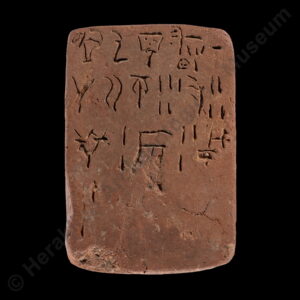
A syllabic writing system used in Crete and the Aegean in the late Protopalatial and the Neopalatial period. Although Linear A has not yet been deciphered, we know that it is a syllabic script consisting of signs representing syllables (syllabograms) and signs representing objects, commodities or living creatures (logograms). The signs were incised by scribes on small rectangular tablets of unbaked clay and on various artefacts. Although the primary purpose of Linear A was the recording and storage of accounting information, the script was also found on artefacts used in religious rituals and events, indicating that it was associated with religious expression and the transcendental sphere. The tablets recorded brief accounting lists of agricultural goods (figs, cereals, olives, wine and olive oil), textiles and vessels, people and animals (sheep, goats, cows, pigs). One group of inscriptions is known as a “libation formula”, variants of which are found on different ritual objects, particularly stone offering tables. These inscriptions probably had a religious significance and ritual use, reproducing a standardised hieratic formula, probably a prayer or invocation.